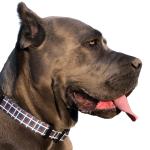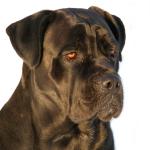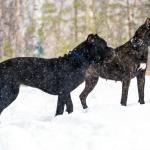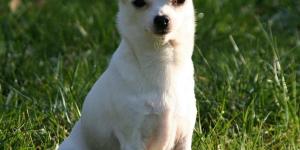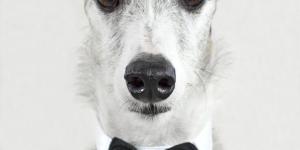Cane Corso

The Cane Corso or Italian mastiff is undoubtedly, together with the Neapolitan mastiff, one of the most impressive Italian dog breeds. Its name derives from the Latin " cohors ", which means "protector, guardian of the farmyard".
If you are thinking about adopting a cane corso, it will be fundamental to investigate their character, the training, the physical characteristics and even the possible health problems that affect this breed. Only in this way will you guarantee a good integration into your home. Continue reading this AnimalWised breed file to know everything about the Cane Corso.
- Europe
- Italy
- Group II
- 5-14
- 14-18
- 18-22
- 22-27
- 27-31
- More than 31
- 2-7
- 7-22
- 22-55
- 55-100
- 100-220
- 8-10
- 10-12
- 12-14
- 15-20
- Low
- Meidum
- High
Origin
The cane corso is a direct descendant of the Roman Molossian, known as canis pugnax, a huge molosser that was used in the first century as a war dog . They worked on the same battlefield, along with the fighters, and were excellent guard dogs. Their presence in the arenas was also popular, when they fought against bears, lions and other wild animals that mattered to the European continent.
The Italian mastiff became a popular dog in Italy, common among the working class. Although at one time its population was considerably reduced, with only a few specimens remaining in the province of Apulia. Apart from monitoring farms, the Cane corso dog was also an excellent herding dog. It was not until 1970 that systematic breeding of this breed was resumed.
Physical appearance
The Italian mastiff is medium to large in size, very sturdy and strong, yet elegant at the same time. The head is broad and slightly convex in its anterior part. The mid-frontal groove is evident and the naso-frontal depression well marked. Their nose is black and the muzzle notoriously shorter than the skull. The eyes are medium, ovoid, slightly prominent and dark in color. Their ears are triangular, pendant and high insertion. Traditionally they are amputated, although this incredibly cruel custom is disappearing little by little and is even illegal in many countries.
The body is strong and robust, but not chubby. On the contrary, the cane corso is one of the most elegant bulldogs that exist. Their upper line is straight and very muscular. Their chest is broad, deep and long. The tail is of high insertion and very thick at the base. Their coat is dense, shiny and short. They have an inner layer of thin hair. They can be black, lead gray, slate gray, light gray, light fawn, dark fawn, fawn red or brindle.
Measurements of the Italian corso dog :
- Males: between 64 and 68 centimeters to the cross, weighing between 45 and 50 kilograms.
- Females: between 60 and 64 centimeters to the cross, weighing between 40 and 45 kilograms.
Character
Breeders working with this breed seek a very specific temperament in the dog. They should be good guardians, either to protect the family, livestock or property. Qualities related to big game and livestock are also sought.
It is an independent dog, generally territorial and very protective. They create a very close bond with their family, especially with the children, whom they care for and protect. Unlike other dogs of this nature, the Cane Corso is exceptionally patient and careful, watching over the movements of the smaller ones so as not to harm them. They are also very energetic dogs, and love to exercise. So, they are ideal for active families and with experience in basic obedience and dog management. However, they are quite quiet at home.
They are usually distant with strangers and often very self-assured, acting proportionately at all times. Do not forget that this description can vary according to the training the dog receives, however these are general guidelines of the behavior that are usually present.
Health
It is important to check the state of health of the cane corso on a regular basis. For this it is advisable to go to the veterinarian every 6 or 12 months, performing a complete analysis to rule out any incipient health problems. It is also necessary to follow the vaccination schedule for dogs and deworm them (internal and external), following the indications of the professional. In addition, this breed is prone to suffer from the following diseases :
- Elbow dysplasia
- Hip dysplasia
- Gastric torsion
- Vaginal hyperplasia
- Respiratory problems
- Heatstroke
- Glandular hypertrophy
- Entropion
- Ectropion
- Demodex scabies at birth
If you follow our tips correctly and take great care of your Cane Corso, you can enjoy spending life with them for around 10 to 14 years.
Training a Cane Corso
It is very important to initiate training of the cane corso over three weeks of life and until 12, during the period of socialization. You will have to teach them how to inhibit the bite, socialize with people, animals and environments of all kinds and begin with basic obedience commands: sit, stand still, lie down or come here. These are fundamental for your safety.
Remember that a properly socialized and educated cane corsos can be great companions and will tolerate strangers, both human and canine. However, one who has not received the correct socialization and education can be extremely territorial, distrustful and even aggressive with people and dogs. Even well socialized, the cane corso is not suitable for new dog owners.
Training is not difficult with this breed if it is done correctly and using positive reinforcement. Traditional methods are very counterproductive to train this breed (or anyone) and, when misapplied, can be counterproductive to generate fear and unwanted behaviors in the animal.
Caring for a Cane Corso
The cane corso is a dog that needs simple care, because we will not need to dedicate long hours to its maintenance. However it is important to know some basic details to know what to take into account before adopting one.
To begin with, it is necessary to brush them weekly to eliminate dead hair. Use brushes with short and soft spikes, so they do not damage their skin. On the other hand, bathe them every one or three months, depending on the level of dirt, to avoid damaging the natural protection layer of their skin.
Although not an overly active dog, the cane corso needs long walks daily to maintain its muscles and release accumulated stress from the body. Recommended three daily walks of about 30 minutes each and, if possible, accompanied by physical exercise. You can also combine outings to the outside with activities related to smell, which often promote relaxation and well-being.
It is recommended that they be kept in rural settings where they can exercise and show their natural behavior. However, they are not dogs that must live abroad, their coat is very thin and sensitive to calluses. They must have a comfy bed at all times.
Vídeo de Cane Corso
Cane Corso photos
